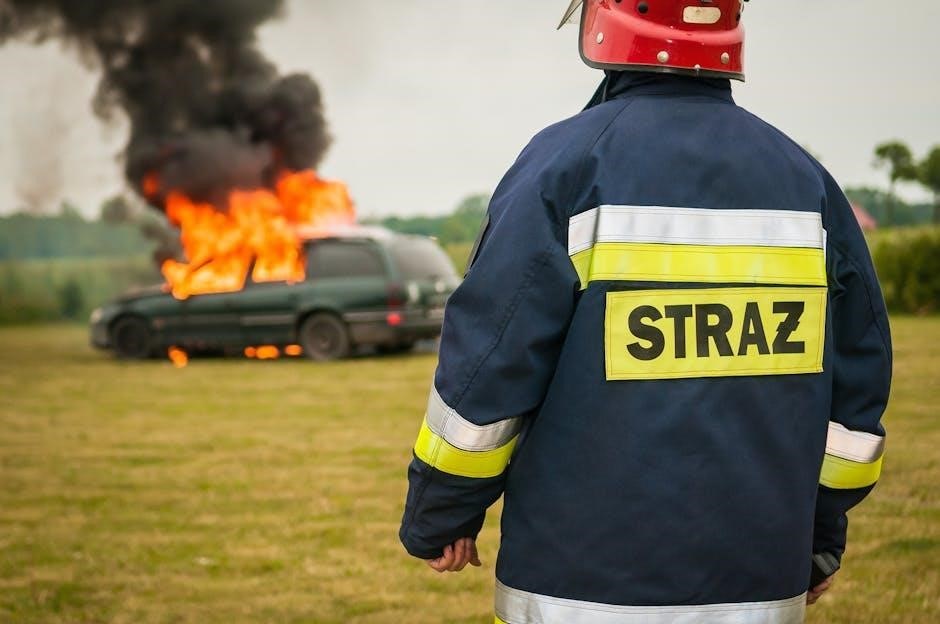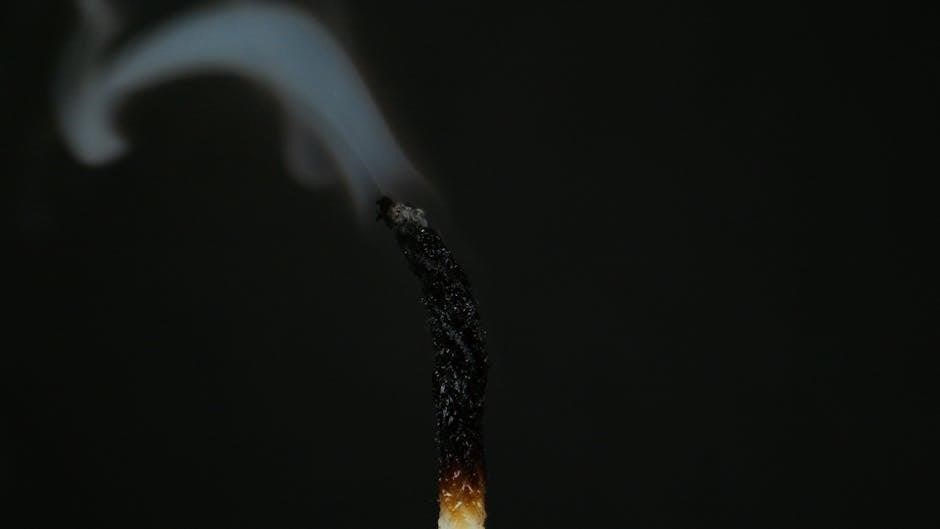Fire extinguishers are essential safety devices designed to control or extinguish small fires․ They come in various types, each tailored to specific fire classes (A, B, C, etc․), ensuring effective fire management and prevention․ Proper selection and use are critical for safety․

1․1 Importance of Fire Extinguishers in Safety
Fire extinguishers are crucial for preventing fires from spreading and reducing potential damage․ They provide a first line of defense, allowing individuals to act quickly in emergencies․ Properly used extinguishers can contain or extinguish small fires before they escalate․ Their presence is essential in homes, workplaces, and public spaces, as they empower people to take immediate action, potentially saving lives and property․ Regular maintenance and understanding their use are vital to ensure effectiveness in critical situations․

1․2 Overview of Fire Extinguisher Types and Uses
Fire extinguishers are categorized into types based on their effectiveness against different fire classes․ Common types include water, foam, dry powder, CO2, and wet chemical extinguishers․ Each type is designed to address specific fire hazards, such as Class A (combustible materials), Class B (flammable liquids), and Class C (electrical fires)․ Understanding their uses ensures proper application, enhancing safety and efficiency in fire emergencies․ Selecting the right extinguisher for the fire class is critical to effectively control and extinguish fires․

Types of Fire Extinguishers
Fire extinguishers are categorized into types like water, foam, dry powder, CO2, and wet chemical, each designed for specific fire classes and hazards․

2․1 Water Extinguishers (Class A Fires)
Water extinguishers are designed for Class A fires, which involve combustible solids like wood, paper, cloth, and plastic․ These extinguishers work by cooling the fuel, removing the heat element from the fire triangle․ They are typically red in color and suitable for general use in homes and offices․ The capacity of a Class A extinguisher is determined by multiplying the number preceding the letter “A” by 1․25․ However, they should never be used on electrical or grease fires, as water conducts electricity and can worsen certain fires․
2․2 Foam Extinguishers (Class A and B Fires)
Foam extinguishers are versatile and effective against Class A and B fires․ Class A fires involve combustible solids like wood and paper, while Class B fires involve flammable liquids such as gasoline or paint․ Foam extinguishers work by creating a barrier between the fuel and oxygen, starving the fire of oxygen․ They are particularly useful in industrial and commercial settings where such fires are more common․ However, they are not suitable for Class C or grease fires․ Regular maintenance is essential to ensure the foam remains effective and free from contamination․

2․3 Dry Powder Extinguishers (Class A, B, and C Fires)
Dry powder extinguishers are multi-purpose and effective against Class A, B, and C fires․ They work by releasing a fine powder that smothers the fire and disrupts the chemical reaction․ These extinguishers are ideal for fires involving flammable solids, liquids, and gases, as well as electrical fires․ However, they are not suitable for Class D or grease fires․ The powder can be messy and reduce visibility, so they are best used in open spaces․ Regular inspection is crucial to ensure the powder remains free-flowing and effective․
2․4 Carbon Dioxide (CO2) Extinguishers (Class B and C Fires)

Carbon dioxide (CO2) extinguishers are effective for Class B (flammable liquids) and Class C (electrical) fires․ They work by displacing oxygen, suffocating the fire without leaving residue, making them ideal for sensitive equipment․ However, CO2 extinguishers should not be used in confined spaces, as they can displace breathable air, posing safety risks․ They are commonly used in laboratories, data centers, and areas with electrical equipment․ Regular maintenance is essential to ensure the pressure and functionality of CO2 extinguishers remain optimal for emergency situations․
2․5 Wet Chemical Extinguishers (Class A, F, and Some B Fires)
Wet chemical extinguishers are highly effective against Class F fires, involving cooking oils and fats, and Class A fires, such as wood and paper․ They are also suitable for some Class B fires, like flammable liquids․ These extinguishers work by smothering the fire and cooling the surface, preventing re-ignition․ They are commonly used in commercial kitchens and areas with deep-fat fryers․ Wet chemical extinguishers are not recommended for Class C (electrical) fires, as they can conduct electricity and worsen the situation․ Regular inspection is crucial to ensure their effectiveness in emergencies․
Proper Use and Maintenance
Proper use and maintenance of fire extinguishers are critical for ensuring their effectiveness in emergencies․ Regular inspections, recharging, and training on the PASS technique are essential for safety and compliance․
3․1 How to Use a Fire Extinguisher: The PASS Technique

The PASS technique is a widely accepted method for using fire extinguishers effectively․ Start by Pulling the safety pin or ring to release the lock․ Next, Aim the nozzle or hose at the base of the fire, avoiding direct contact with flames․ Then, Squeeze the handle to release the extinguishing agent․ Finally, Sweep the nozzle from side to side, covering the entire area of the fire with the agent․ This method ensures proper control and minimizes risks during an emergency․
3․2 Regular Inspection and Maintenance Requirements
Regular inspection and maintenance of fire extinguishers are crucial to ensure their effectiveness in emergencies․ Inspect extinguishers monthly, checking the pressure gauge for proper levels and examining for visible damage or tampering․ Ensure all units are easily accessible and not obstructed․ Follow the manufacturer’s service schedule, typically annual professional inspections․ Replace or recharge extinguishers as needed and maintain clear signage․ Proper upkeep guarantees reliability and safety, preventing fires from escalating due to malfunctioning equipment․

Common Mistakes to Avoid
Using the wrong extinguisher for the fire class and improper handling are common mistakes․ Always follow the PASS technique and ensure the extinguisher is suitable for the fire type․
4․1 Using the Wrong Extinguisher for the Fire Class
Using the wrong fire extinguisher for a specific fire class can worsen the situation․ For example, water extinguishers are ineffective on electrical fires (Class C) and can cause harm․ Similarly, CO2 extinguishers are not suitable for Class A fires․ Always match the extinguisher type to the fire class to ensure safety and effectiveness․ Misuse can lead to fire spread or electrical hazards, emphasizing the importance of proper selection and training․
4․2 Improper Handling and Technique
Improper handling and technique can render a fire extinguisher ineffective or even dangerous․ Common mistakes include not following the PASS method (Pull, Aim, Squeeze, Sweep) or failing to maintain a safe distance․ Incorrect nozzle placement or insufficient sweeping motions may not fully extinguish the fire․ Additionally, improper handling can lead to accidental discharge or equipment damage․ Regular training is essential to ensure users understand proper techniques and avoid critical errors during emergencies․
Guide to Choosing the Right Fire Extinguisher
Selecting the right fire extinguisher involves assessing fire risks, considering the environment, and choosing the appropriate type and size․ Proper selection ensures effective fire control and safety․
5․1 Assessing Fire Risks in Different Environments
Assessing fire risks involves identifying potential fire hazards and determining the likelihood of fires in specific environments․ Homes, workplaces, and public spaces have unique risks, such as cooking fires, electrical hazards, or flammable materials․ Understanding the fire class (A, B, C, etc․) is crucial for selecting the right extinguisher․ For example, Class A fires (wood, paper) require water-based extinguishers, while Class B (flammable liquids) need foam or dry powder․ Regular inspections and maintenance ensure extinguishers are ready for emergencies, minimizing fire-related damages and ensuring safety․
5․2 Size and Capacity Considerations
The size and capacity of a fire extinguisher are critical for effective fire management․ Larger extinguishers, such as 30-50 pound models, are suited for high-risk areas with potential for larger fires․ Smaller units are ideal for minor incidents․ Size determines the amount of extinguishing agent, impacting suitability for specific environments․ Proper sizing ensures the extinguisher is manageable for users while providing adequate coverage․ Selecting the right capacity balances portability and effectiveness, ensuring fire risks are mitigated without compromising accessibility or usability․
Fire extinguishers are vital tools for fire safety, with proper selection, use, and maintenance being key to preventing fire-related hazards․ Understanding their types and functions ensures effective emergency response․
6․1 Final Thoughts on Fire Extinguisher Safety
Fire extinguishers are critical tools for preventing fires from escalating, but their effectiveness depends on proper selection, maintenance, and user education․ Understanding fire classes and extinguisher types ensures safe and appropriate use․ Regular inspections and training are essential to maintain readiness․ Misuse or poor maintenance can lead to ineffective fire control, highlighting the importance of strict adherence to safety guidelines․ By prioritizing fire extinguisher safety, individuals and organizations can significantly reduce fire-related risks and protect lives and property․
